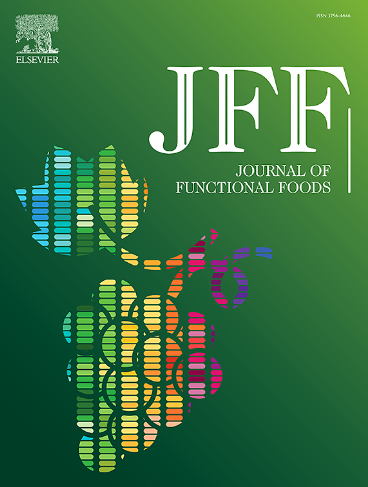刺梨提取物可通过范可尼贫血途径缓解乙醇诱导的体内外氧化应激
IF 4
2区 农林科学
Q2 FOOD SCIENCE & TECHNOLOGY
引用次数: 0
摘要
刺梨提取物(PPE)具有多种作用,包括抗氧化、降血糖和抗肥胖特性。虽然其在酒精性肝病(ALD)预防中的作用尚未得到充分研究,但这项研究揭示了PPE的化学成分(总蛋白、糖、酚类、类黄酮和多酚类)。通过ALD动物模型,我们发现了12种PPE代谢物直接进入肝脏,通过降低ALT、AST和MDA水平,升高SOD和GSH水平,增强ADH和ALDH酶活性来减轻酒精诱导的氧化损伤。通过检测乙醇诱导的HepG2细胞,PPE激活了范可尼贫血(FA)通路,上调了参与抗氧化基因表达的蛋白(ub-FANCD2、ub-FANCI、FANCA)和促进DNA修复的FA复合物蛋白(ub-FANCM、MHF1、FAAP24)。这些发现强调了PPE通过FA通路激活对抗氧化应激和DNA损伤的能力,肯定了其作为天然产物的肝脏保护潜力。本文章由计算机程序翻译,如有差异,请以英文原文为准。

Prickly pear (Rosa roxburghii Tratt.) extract alleviates ethanol-induced oxidative stress in vivo and in vitro via Fanconi Anemia pathway
Prickly pear extract (PPE) exhibits diverse effects, including antioxidative, hypoglycemic, and antiobesity properties. While its role in alcoholic liver disease (ALD) prevention remains understudied, this research unveils PPE's chemical composition (total protein, sugar, phenols, flavonoids, and polyphenols). Employing an ALD animal model, we identified 12 PPE metabolites that directly entered the liver, mitigating alcohol-induced oxidative damage by reducing ALT, AST, and MDA levels, elevating SOD and GSH levels, and enhancing ADH and ALDH enzymatic activity. Examining ethanol-induced HepG2 cells, PPE activated the Fanconi anemia (FA) pathway, upregulating proteins (ub-FANCD2, ub-FANCI, FANCA) involved in antioxidant gene expression and FA complex proteins (ub-FANCM, MHF1, FAAP24) promoting DNA repair. These findings highlight PPE's ability to combat oxidative stress and DNA damage through FA pathway activation, affirming its hepatoprotective potential as a natural product.
求助全文
通过发布文献求助,成功后即可免费获取论文全文。
去求助
来源期刊

Journal of Functional Foods
FOOD SCIENCE & TECHNOLOGY-
CiteScore
9.60
自引率
1.80%
发文量
428
审稿时长
76 days
期刊介绍:
Journal of Functional Foods continues with the same aims and scope, editorial team, submission system and rigorous peer review. We give authors the possibility to publish their top-quality papers in a well-established leading journal in the food and nutrition fields. The Journal will keep its rigorous criteria to screen high impact research addressing relevant scientific topics and performed by sound methodologies.
The Journal of Functional Foods aims to bring together the results of fundamental and applied research into healthy foods and biologically active food ingredients.
The Journal is centered in the specific area at the boundaries among food technology, nutrition and health welcoming papers having a good interdisciplinary approach. The Journal will cover the fields of plant bioactives; dietary fibre, probiotics; functional lipids; bioactive peptides; vitamins, minerals and botanicals and other dietary supplements. Nutritional and technological aspects related to the development of functional foods and beverages are of core interest to the journal. Experimental works dealing with food digestion, bioavailability of food bioactives and on the mechanisms by which foods and their components are able to modulate physiological parameters connected with disease prevention are of particular interest as well as those dealing with personalized nutrition and nutritional needs in pathological subjects.
 求助内容:
求助内容: 应助结果提醒方式:
应助结果提醒方式:


